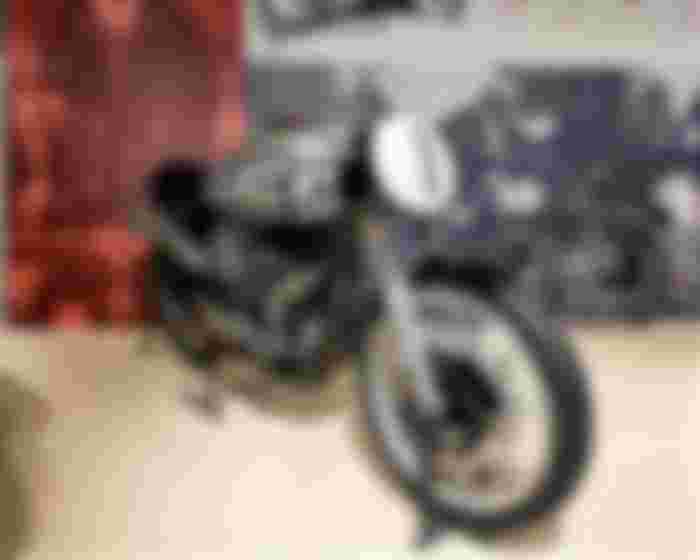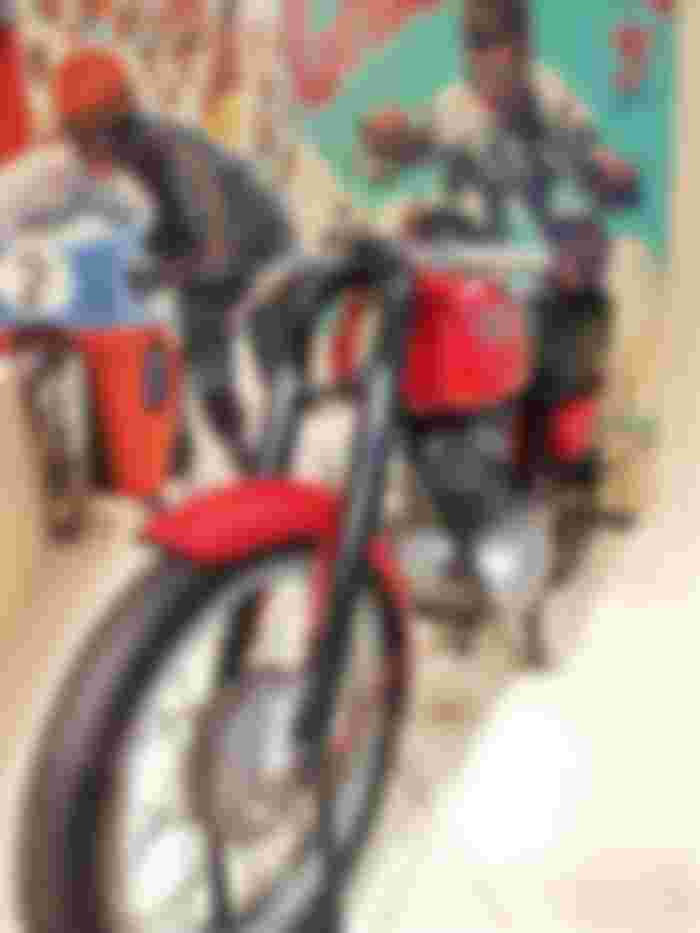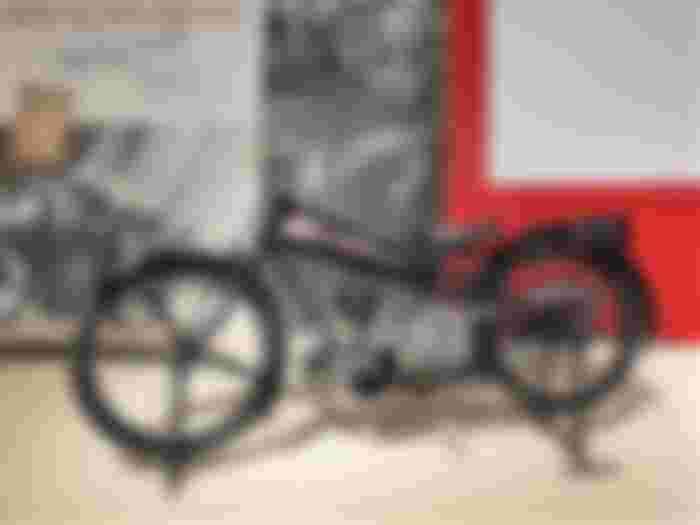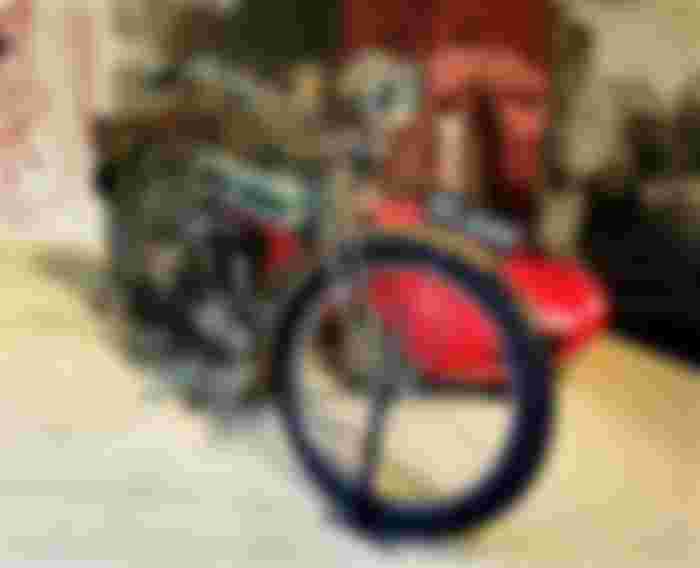
I can tell you we had an amazing time at the Ulster Transport Museum. This separate building is called Land, Sea & Sky Galleries which features different transport means in a different category. These Motorcycles are part of the land gallery together with the early bicycles that I recently published.
Let's have a look.
George Brockerton's Bitza Motorcycle

George Brockerton (1898-1965), of Coleraine Antrim, was a superstar of his time. He is the only Irishman to hold a Brooklands Gold Star for speeds in excess of 100mph (161 km/h) and in 1929, he is part in organising the very first North West 200. Brockerton and W.R. Chamberlain built this motorcycle using parts from many other makes of motorcycle, including Triumph, Norton, Sunbeam and Velocette.
Brockerton called the motorcycle"Bitza" because it was made from "bits a this and bits a that".
He went on to prove himself a hero during World War II, leading a convoy of Allied vehicles to safety at Dunkirk. After the war, he took up competitive racing again, and was also famous for such dare-devil feats as riding across Carrick-a-Rede rope bridge, County Antrim, and riding the Wall of Death at Barry's Amusement in Portrush, County Antrim.
McCandless Manx Norton Motorcycle

Rex McCandless (1915-1992) was a successful racer, who handled his problem about his Triumph Motorbike successfully. He was an inventor who able to come up with a solution -the legendary "Featherbed" frame. The motorbike was easier to control and this frame was so strong and rigid that it did not twist like other frames. Norton adopted the featherbed frame for use on all of its successful racing bikes. And it dominated the sport worldwide in the 1950s and 1960s.
McCandless felt that the British motorbike industry could no longer compete with that of the Japanese, he then later turned his attention from motorbikes to cars and then to aeroplanes.
Up to this day, the featherbed frame continues to influence motorbike design.
Tom Herron's Bianchi Motorcycle

Tom Herron (1948-1979) was a successful Grand Prix racer in the 1970s. He is from Lisburn in County Down and was particularly admired in his career as a "privateer". Because rather than being backed by a major motorcycle company, he prepares his own vehicles for racing.
He purchased his Bianchi motorcycle from his uncle and converted it into his first racer.
Tom Herron finally secured backing from Suzuki GB in 1979. His career was brought to a tragic end just months later, following a serious crash in the North West 200. It is known as "Black Saturday" when he died when the race also claimed the lives of three riders. Just before his death, he was restoring this motorcycle to its original condition.
Stanley Woods and the Cotton Motorcycle

Stanley Woods (1903-1993) was the most successful Isle of Man TT (Tourist Trophy) racer of the 1930s. He had ten wins in the race, which made him a record holder for an impressive twenty-five years. He also excelled at several versions of the sport, including ice-racing, scrambling and speed events. He was viewed with awe and respect as an unbeatable superstar. He raced a Cotton Motorcycle similar to this 1923 example. This motorcycle ha a side-valve engine, whereas his motorcycle was fitted with an overhead valve engine.
Stanley Wood's fame continued long after his racing career ended in 1966, yet he remained a modest man. In 1979 he famously queued up for the first Classic Bike Show in Manchester, only to be welcomed as a guest of honour at the same event three years later. In 1983, at the age of 80, he took part in the National "Classic Bike" Event.
Model H Triumph Motorcycle

With the outbreak of World War I in 1914, the Triumph factory in Coventry, West Midlands, England, geared its production to support the war effort, supplying ohver 30, ooo motorcycles to the despatch riders of the Allied forces. So reliable over rugged terrain was the Model H that it was nicknamed "The Trusty".
The Model H went out of production in 1925, but Triumph went from strength to strength. Having overcome many problems, including financial losses and factory fires, the company remains a privately owned British company today. It continues to produce innovative motorcycles, such as the Rocket III.
1939 Velocette Motorcycle
Registration GZ 2586

The Veloce company of Hall Green, Birmingham was a small, family-run motorcycle manufacturer. Before the Second World War, the firm was well known for constructing both road-going and racing motorbikes of high quality. Today the firm is probably best to remember of their LE Velocette (LE stands for Little Engine) motorbike, which was a favourite of many British police forces. It remained in production from 1948 until 1970.
The Velocette on display here is a GTP model that was introduced in 1930 and continued in production until 1946. The GTP was a reliable, lightweight 250cc motorcycle with good power delivery and pleasant steering. This example was built in 1939 and originally supplied to the War Department, who disposed of it in 1945. It was refurbished and used by various owners in Belfast and County Down.
And there you go. Isn't it cool to see these bikes that we don't see every day?

I enjoy writing this as my husband loves racing since he was 5 years old and won many trophies and awards. He was also part of the Antrim Club. He stopped racing when he is 14 or 15. But last month he bought a bike again and told me of thinking to go back to racing to keep him fit. I say nothing.
And here are some of his trophies:



Ulster Transport Museum is a must-see tourist attraction here in Northern Ireland aside from the Titanic Belfast, Game of Thrones location, Crumlin Road Gaol and many more. So make sure to put it in your bucket list.











My husband would enjoy visiting this Motorcycles gallery.He is Motorcycles fun.He taught me a lot about it,so I know a lot of them too. Pictures are great dear.Could you sit on one motorcycle?